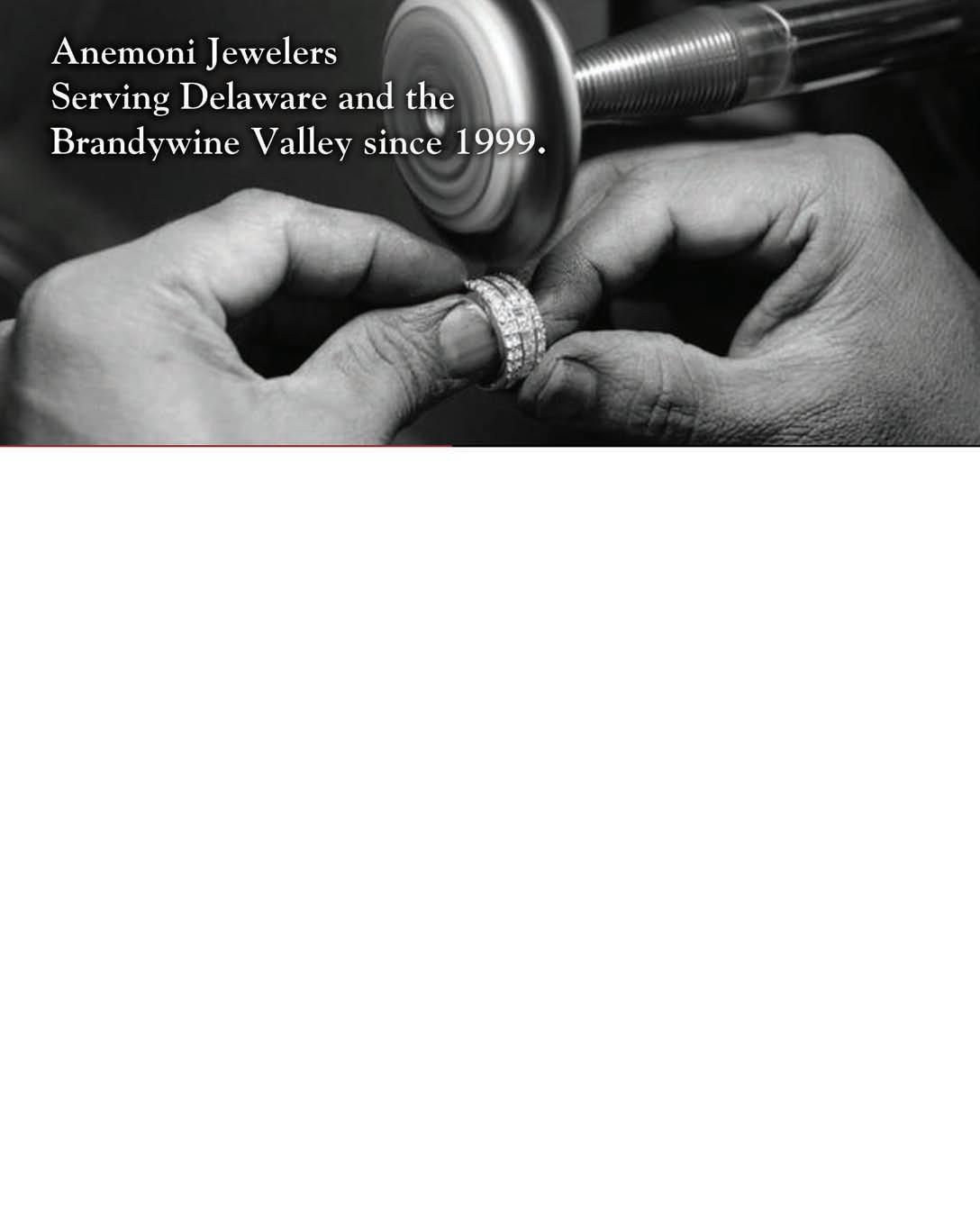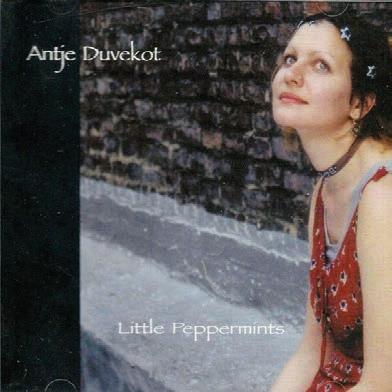






































































































































































































































































In this edition of Greenville & Hockessin Life, writer Ken Mammarella takes readers on a behindthe-scenes tour of the Winterthur you don’t know. The Winterthur Museum, Garden & Library is much more than the dozen and a half rooms on the standard tour, its famed gardens and the annual festivities of Yuletide and Point-to-Point that draw thousands of visitors. The property covers almost 1,000 acres, the stewardship by the du Ponts go back to 1839, and the collection numbers almost 90,000 items, so there’s plenty to learn from this story.
For the past several years, the Yellowstoners have been performing their unique brand of mellow mountain music before appreciative audiences at area venues. Backed by original songs and two CDs, the band transports its listeners to a bluegrass and folk paradise. Greenville & Hockessin Life recently spoke with John Corrigan and Casey Neal about their musical influences, their collaboration as songwriters and their love of playing at Dew Point Brewing Company in Yorklyn.
Speaking of Yorklyn, one of the stories in this edition focuses on some of the interconnected development issues that have been a concern for residents in the Yorklyn and Hockessin area in recent years. Residents of Yorklyn and Hockessin woke up one day in early September of 2021 to find that 10 acres of luxurious trees had been eviscerated along Yorklyn Road at the intersection of Hockessin Hills Road. Locals say they never saw the desecration coming, and they have been reeling from the event ever since. Writer Colleen Cochran talked to local residents about their concerns about the removed trees, and the 61-unit subdivision called Quarry Walk that is planned for that area.
Continued on Page 7
This edition also features a story about the history and beauty of Kennett Pike. Its history can be traced with dramatic accuracy, including its birth as a toll road in 1811 and death as a toll road in 1919, as well as its birth as a modern highway on June 12, 1920. Its history also led to its beauty, and of course the du Pont family members and their respective business interests played an important role.
Much like the vision of its owner Sally Guare Hunsinger, Shish Interiors, the subject of the photo essay in this edition, blends form and beauty to create practical design ideas that meld perfectly with the busy lives we live.
We hope you enjoy these stories as much as we enjoyed preparing them for you. Please contact us with comments and suggestions for future stories. The next edition of Greenville & Hockessin Life will arrive in the fall.

Sincerely,
Avery Lieberman Eaton averyl@chestercounty.com
Stone Lieberman stone@chestercounty.com
Steve Hoffman, Editor editor@chestercounty.com
Cover design: Tricia Hoadley
Cover photo: Winterthur Museum, Garden & Library




By Ken Mammarella Contributing Writer
Winterthur Museum, Garden and Library is much more than the dozen and a half rooms on the standard tour, its famed gardens and the annual festivities of Yuletide and Point-to-Point that draw thousands of visitors. The property covers almost 1,000 acres, the stewardship by the du Ponts go back to 1839, and the collection numbers almost 90,000 items. So there’s lots of space, time and stuff for interesting stories. Let’s go behind the scenes.
Why is Winterthur arranged the way it is?
Winterthur founder Henry Francis du Pont was “very particular in telling stories” by how he arranged the rooms, said Reggie Lynch, director of interpretation and engagement.

In some rooms, du Pont grouped furnishings from the same era and the same region, “so you could see what the Empire style looked like in one room,” she said.
“He also was very interested in aesthetics, so when he was mapping out a room, he was thinking about things like shape and line and color and the placement of the objects in the space.” For instance, the Montmorenci Hall (which hosts the giant Christmas tree during Yuletide) features an oval spiral staircase and Federal pieces with similar oval shapes.
Yet there can be changes.

Continued on Page 10
Continued from Page 9
du Pont redecorated seasonally, pulling the colors and shapes from what was blooming outside for drapery, upholstery and even rugs, she said. The museum today rethinks fabrics every other year or so, because handling them too much risks damage.
Staff members have rearranged furniture in some rooms to accommodate the flow of visitors. That’s why an upright piano was shifted in the Empire Parlor on the fifth floor.
Staffers have also moved some small objects further into the room so that they are less likely to be involved in “touching incidents” by visitors. Again, it’s about avoiding damage.
Yet change is not everywhere.
In the 1970s, the board froze the arrangements in some spaces, including 14 on the introductory tour. (The tour runs 17 to 19 spaces, depending on the season, and counting spaces that you can only see into.)
“It was thought that these spaces best exemplify H.F. du Pont’s aesthetics and efforts to preserve the history of specific styles, regions and eras of the decorative arts,” Lynch said.
“Any time we move an object in any of these spaces, we revisit the move after a period of time, assess the visitor needs and safety of the collection and decide whether or not to restore the space or move on to the board for approval to retain the new configuration for a longer period. All of these


moves are documented down to the most minute detail. The records are impressive.”
The dozens of objects in each room – whether in the same spot for decades or in a new one – can provide new experiences for repeat visitors, Lynch said.
“Every time I walk through a room, I notice new things, like how he was pairing the color of a certain object next to a certain window treatment,” she said.
That insight about how du Pont felt about shape and color among nearby objects evokes the famous stance of Pennsylvania art collector Albert C. Barnes in his eponymous museum. And yes, du Pont and Barnes knew each other and exchanged letters. “Pretty fascinating,” Lynch said of their friendship.

Winterthur founder Henry F. du Pont considered multiple factors in designing rooms, including where and when the items were made, plus their shapes, lines and colors. These three photos of the Chinese Parlor show how it has evolved since 1935, when the black and white photo was taken. The dramatic wallpaper and a chandelier remain, and a sofa and a folding screen are in the same places, but much of the furniture and the smaller decorative elements have changed and moved. The flooring and the window treatment had also changed by 2006, when the second photo was taken. The third photo, from 2016, shows a broader version of the room, with the piano.
“Winterthur’s collection is far more expansive than many people realize,” collections director Alexandra Deutsch said. “While the museum is the home of some of the finest 18th and 19th century decorative arts made and used in America, Henry Francis du Pont’s visionary collecting created a foundation that has allowed Winterthur’s curators to expand the collection in innovative and inspiring ways. Today, guided by a collections policy that acknowledges the global nature of the collection, acquisitions that significantly expand Winterthur’s ability to share complete histories with our visitors, students and scholars are a top priority. This selection of objects provides a glimpse of recent acquisitions which document histories previously untold in Winterthur’s galleries and museum rooms.”
Here are three recent acquisitions to the collection of nearly 90,000 objects.
A 2023 quilt by Sharon and Jemica Williams is the first quilt by a known African-American designer and maker to enter Winterthur’s collection. “The design is a fresh interpretation of the ‘My Way’ style of freeform piecing and quilting for which the quilters of Gee’s Bend, Alabama, descendants of enslavement, are famous,” Deutsch said. Sharon Williams “wants people to see these colors and admire them,” and that brings her joy.
“An arresting portrayal of a dark-haired naval captain, Don Juan de Dios de Parreno y Pardo, intimates the history of maritime politics of Europe and the Americas in the early part of the 1800s,” said Kedra Kearis, associate curator of art and visual culture. “Seated at a table with navigational tools spread over an indeterminate map, the confident Pardo gestures to his offshore frigate that bears the pre-Republic flag of Spain. This conversation piece invites an array of questions. Who is this captain? Is his vessel heading out to sea or This

returning? What does this portrait tell us about Spain’s presence in the Americas? Sure to intrigue visitors, this picture joins Winterthur’s strong holdings of early 19th-century portraits painted in the United States. It allows for important conversations about the exchange of art traditions across the Atlantic and contact between Spain and indigenous people of the Americas.”
California’s state flower, the golden poppy (also called the cup of gold), is the dominant inspiration for each vessel of a “gilded beverage bouquet,” said Ann Wagner, Winterthur’s curator of decorative arts. The 1915 hot chocolate set was commissioned for a patriotic Californian named Anita May Baldwin, who inherited a ranch called Anoakia that covered thousands of acres. It was likely designed with her input and created in Rhode Island by Gorham Manufacturing, with the Lenox Ceramic Art Company providing the fitted white porcelain liners. It is on view in the museum’s galleries.
Continued on Page 12


Continued from Page 11
“The most common questions of the unusual variety are ‘Is the house haunted?’ and ‘Are there ghosts?’ ” said Eileen Scheck, manager of tour programs. She invites those interested in the supernatural to listen to a 2023 “Ghost Stories of Winterthur” podcast featuring a few ghost stories told by employees.
Museum guide Tyler Horne enjoys answering unusual questions. Here are two of his favorites.
“What’s up with the lights?
“The lights here at Winterthur were installed as part of a lighting project years ago, and they do not look like they did when du Pont was living here,” Horne said. “However, the
majority of Winterthur always had electric lighting, as we had an electric generator here in 1893.”
Were George Washington and Henry Francis du Pont friends? Why is there so much Washington stuff here? Did Washington ever visit here or sleep here?

Visitors often remark about an eerie vibe or disconcerting feeling they get from the long hallways at Winterthur, with some describing the sensory experience as akin to a visit to Disney’s Haunted Mansion.
“Remember, Henry Francis du Pont was alive much more recently than Washington, from 1880-1969. du Pont was a collector of all things American from 1640-1850, and there was a point in time after the American Revolution when you couldn’t walk five feet without seeing Washington depicted in art in some way. du Pont admired Washington for his heroism during the Revolution and for his decision to support the new Republic rather than name himself king.”

The du Ponts and sheep go back to 1801, when Pierre S. (father of E.I.) imported four Merino sheep from France. The only one that survived was named Don Pedro, who became famous as a breeding ram. When Don Pedro died, the du Ponts received condolences from Thomas Jefferson.
Livestock farming at Winterthur began in 1810, when E.I. bought the land, and ended in 1969, when Henry F. du Pont died. He had a world-renowned herd of Holstein cattle, plus sheep and goats. A Holstein named Winterthur Boast Ormsby Ganne set a world record in 1933, for producing 1,004.2 pounds of butterfat. Her daily average was eight gallons of milk.
At its peak, the Winterthur farm numbered 1,200 Merino, mixed Merino and common sheep, “the largest and finest flock in the United States,” according to “The Delaware Woolen Industry.”
In 2007, Winterthur entered an agreement with Greenbank Mill to house some of their sheep, said Kevin Braun, supervisor of arboriculture and natural lands. Greenbank works with Winterthur and Historic Williamsburg to preserve historic breeds of sheep and educate city folk about farm life.
“Goats returned to Winterthur in 2014,” he said. “We brought them back for historic value and to help us control invasive species. We will move them around the property, put up temporary fencing, and allow the goats to browse the vegetation. They are very efficient. We use them in tough-to-mow areas where their four-legged footing is much better than trying to get equipment to the areas.”
He added, “We will sometimes bring the goats out for programs on the property. Every once in a while, we will have tours that go up to the barn to meet the goats.”
Continued on Page 14


Continued from Page 13
Of Winterthur’s 118 buildings, some for decades have served uses that sound unusual for a museum, including shops for painting, carpentry and auto repair; a post office; a fire station; and a railroad station. They date back to when it included multiple farms, had many more workers and, at its peak, covered 2,500 acres.
Most specialized buildings are not open to the public, but the post office (a fixture since 1900 and now behind the museum store) can be used by anyone.
“We have an active fire brigade. We are self-sufficient in that we operate our own public water system and treat our own wastewater,” said John W. Castle, facilities services director. “The railroad tracks are in use, and the train goes by twice a day going from Wilmington to Reading and back. It mostly carries scrap iron and other bulk freight as the rails are not certified for passenger service.”
Continued on Page 16

Some visitors to Winterthur enjoy sending mail from the U.S. Post Office on the estate so that their mail has a Winterthur postmark.


Continued from Page 14
In 2017, the Partnership for the Delaware Estuary came up with the idea of breeding freshwater mussels to clean up the watershed.
“Each adult mussel can filter more than 10 gallons of water per day,” the nonprofit writes on its Mussels for Clean Water Initiative page, adding that the process “can remove substantial amounts of microscopic particles, including many forms of pollutants.”
One of the many problems to increase the mussel population is finding comfy bodies of water for them to grow up in, and two ponds at Winterthur were the main focus at first.
“Many of Delaware’s freshwater waterways were once home to freshwater mussels, and some still are, albeit with fewer mussels,” said Kurt Cheng, senior science manager for the partnership. “Mussels are growing well in all of the





The equipment on the surface of this pond at Winterthur is what the Partnership for the Delaware Estuary uses to raise thousands of freshwater mussels, which eventually will be placed in other Delaware waterways, where the partnership monitors the water quality.
areas we have tested so far.”
A pond southeast of Winterthur’s library (along Clenny Run Road at the intersection with Duck Pond and East Barn roads) and ponds at Talley Day and Rockwood parks continue to nurture mussels.
To learn more about Winterthur Museum, Garden & Library, visit www.winterthur.org.


























For the past several years, the Yellowstoners – John Corrigan on mandolin and percussion, Casey Neal on guitar and banjo and Jon Lukawski on bass – have been performing their unique brand of mellow mountain music before appreciative audiences at area venues. Backed by original songs and two CDs, the band transports its listeners to a bluegrass/folk paradise. Greenville & Hockessin Life recently spoke with John and Casey about their musical influences, their collaboration as songwriters and their love of playing at Dew Point Brewing Company in Yorklyn.
Greenville & Hockessin Life: Before we start talking about The Yellowstoners, let’s begin at the beginning –your individual introductions to music. Let’s start with you, John.
John: My first influences were my mother and father, who introduced me to bands like the Beatles when I was young. My older brother also got me into playing music, and I followed in his footsteps by learning how to play guitar. When I was in college, I joined some friends on a trip to Wyoming and Montana, and that was my first real exposure to bluegrass and folk music. When I got back to the University of Delaware, we started a band known as Delaware Rag and focused on the folk-bluegrass genre. The joke was that when we were out west that if one guy got a banjo, the other would have to get a mandolin, and that became the preface to the band. We eventually needed to fill our sound out, and that’s when we got Casey in the band. He and I clicked immediately, and we began writing songs together.
Continued on Page 20

Continued from Page 18
Casey, when were you first introduced to music?
Casey: I was an athlete through high school and didn’t get into music until after college, when I began taking guitar lessons at Mal’s Music in Newark. He was a great teacher and really turned me on to music. A few years later, I met John, joined Delaware Rag in 2003 and things started clicking. I had been in a few electric bands before Delaware Rag, but the bluegrass instrumentation that they were adopting was interesting to me, so I fell into the acoustic music scene with John.

You toured often as members of Delaware Rag. What was that experience like?
John: We toured out to the Midwest and back, and then to Florida and back. Going down to Florida was amazing, because we played a lot of big clubs. We called ourselves a unique bluegrass experience, and we used to wear three-piece suits we picked up from Goodwill as an homage to the original bluegrass heroes. The moments that were best were when we walked into a gig and no one knew who we were, but they realized that we were the band and there to play. For me, it was about the music, and putting our brand of music out there.
Casey: It was exciting to get out on the road and play our music to new audiences, but there were also a lot of logistical hiccups, such as when our car broke down one time and a few other unpredictable things that came when we were on a shoestring budget.
When one door closes, another door opens. Delaware Rag disbanded in 2008 and was followed by the formation of The Yellowstoners. When and how was the band formed?
Casey: Several members of the band moved away from the area, but John and I were able to stay connected through songwriting because in the latter stages of Delaware Rag, we morphed from a bluegrass band into an act that had bluegrass instrumentation with original songs. We developed a good rapport bouncing ideas off each other. I was living in Indiana at the time, but the technology at the time enabled us to send files back and forth to each other.
John: When Casey moved back to the area, we decided to start performing and writing together. We then took a hiatus to Wyoming to write songs with a mandolin and some guitars, and that’s when The Yellowstoners were formed – in 2012 – and we began performing as The Yellowstoners in 2015.
One winter, Casey and I hiked 15 miles into the back country of Wyoming and stayed the night, and it was one of the most inspirational moments we could ask for. It inspired our song, “Whiskey and a Winter’s Moon.”
Describe how the two of you work together.
John: It’s been about the creative process with us – being able to come together with our different ideas and freely bounce them off one another so easily, with no ego involved. It’s about writing something that has a good story, a good feel and a good idea to it. When Casey and I started sinking our teeth into songwriting, we also began growing as musicians.
This article would be remiss if we didn’t talk about the third member of the band. Talk about how Jon Lukawski helps layer The Yellowstoners’ sound.
Casey: Jon is a talented musician and a terrific upright bassist. He soon became an integral part of our sound. He seems to enjoy our sometimesimperfect songwriting process and he has been invaluable as a sound engineer.

John: Jon is fine playing covers, but his heart is behind playing original music. He jumped at the chance to be a part of something where he can help write songs, create arrangements and be a part of our sound and recording.
As defined on your social media page, The Yellowstoners define themselves as crafting “mellow mountain musicthe perfect soundtrack for a campfire with friends... or a venue looking for original acoustic music.” Take a deeper dive into what mellow mountain music is, and tell me how you arrived at that particular genre.
Casey: The entire Western vibe that we experienced when we were out in Wyoming fit what we were trying to do – to take this bluegrass instrumentation and push it – writing melodies and harmonies and chord progressions that didn’t fit a particular style.
John: We want to give our music a Big Sky feel. It’s a dif-
ferent feeling when you are that close to the clouds. We’re not attempting to channel that, but that’s the vein we try to place out songs in.
Locking into a particular kind of music demands finding that sweet niche of finding the right audiences. Talk about how The Yellowstoners have found those audiences.
Casey: We have tried to stay true to what we have wanted to do, and it has opened the doors to where we ultimately play. For instance, we found Dew Point Brewing Company, which has been the perfect setting for our music, and we have gained a lot of fans by performing here. We focus on crafting good songs and see what doors it opens for us.
The Yellowstoners seem to have secured a regular gig at Dew Point Brewing Company in Yorklyn. How did you first connect with the Hoffman family?
Continued on Page 22
Continued from Page 21
Casey: It all happened organically. My wife, Sara and I moved with our two daughters right down the road at about the time the brewery first opened. We sensed a great vibe from the beginning, and Sara approached John Hoffman and told him, “My husband has this great band, and this would be perfect for them to play.” We became one of the first acts to play at Dew Point.
The outdoor, natural setting is perfect. The stage is nestled between the trees. Who wouldn’t want to play here?
John: We don’t really want to be a jukebox band and play other people’s songs and have people talking over us. We would rather have audiences who come to hear the band, and Dew Point is a perfect place for us. People respect musicians here much more than in other places. It’s hard to find venues where they come for the music first. More importantly, everyone knows everyone else at Dew Point, and there is a collective feeling of community here.





Continued from Page 22
You all have other responsibilities in your lives that battle with your music for your time and energy. Do you ever imagine a time in your lives when music will take up a larger plot of space, and if so, what do you imagine it will eventually look like?
John: I have no desire to make a million dollars or become famous from music. I want to continue to have people appreciate and notice our music, and if that happens, that’s all that matters to me. It’s about getting the music out to the people. It’s also about learning, because the more I learn the more I can experience and give to the people who come to see us perform. That’s what drives me.
Casey: I would wake up at my own pace every morning and strum a guitar, because I wouldn’t have the need to find a sliver of time in which to play. That would be a perfect
day. Wake up, play, do something else, come back and play, and have that freedom to be creative when it comes.
Are there any new projects on the horizon?
John: We’re starting a new electric project, where I am playing upright bass guitar and Jon is playing pedal steel. We’re gearing the music more toward the sound of The Highwaymen and Waylon Jennings, blending some covers with a lot of original music. We’re still going to perform as The Yellowstoners, but this new project is about us branching out, evolving and growing with our music.
Casey: It’s the expansion of our sound. When we did The Yellowstoners albums, we overdubbed drums and added some additional ornamentation – the extra bells and whistles – and by adding them, our songs have begun





to take on a new life.
What is your favorite spot in Greenville or Hockessin?
Casey: I like Auburn Valley State Park. I go there a lot. I take the dog on walks there. I think it’s a cool, still largely unknown state park.

John: I enjoy the Auburn Heights Train Museum. That’s mainly because of my memories of having gone there a lot when I was a kid.
Either of you throw a dinner party and can invite anyone – living or not, famous or not. Who would you want to see

around that table?
Casey: To keep it simple, I would love to have my grandfather, Howard Wise, to see me play and write music in a band. He would be stunned. He was an athlete, a minor league baseball player and a football coach, and for him to see me transition from an athlete to a serious musician would be a delight for him. I would also invite Jerry Garcia, because of all the musicians I have a fondness for, I would have to pick him first. He had a major influence on me. He was a perfect musician to be inspired by.
Continued on Page 26


Continued from Page 25
John: I would like to invite my father, William Corrigan, who passed away when I was 19 years old. He saw me in bands in high school but never lived long enough to see me tour and record music, and to be able to sit with him now would be cool. I would also like to invite any songwriter as long as I am allowed to pick his brain: Willie Nelson, Paul McCartney and John Lennon immediately come to mind.
What item can always be found in your refrigerator?
Casey: Blueberries.
John: Ginger ale and fruit.
You can find The Yellowstoners music on all the major music-streaming platforms – Spotify, Apple Tunes, Amazon Music – as well as on YouTube, Instagram and Facebook. Come hear them live at the Dew Point Brewing Company and elsewhere this fall. CDs are available at all shows.
~ Richard L. Gaw





By Ken Mammarella Contributing Writer
Kennett Pike is one of Delaware’s most interesting roads.
Its history can be traced with dramatic accuracy, including its birth and death as a toll road (Jan. 21, 1811-April 30, 1919) and its birth as a modern highway (June 12, 1920).
Its history also led to its beauty.
“Between 1918 and 1920, du Pont family members

and their respective business interests owned 48 percent of the road’s Delaware frontage, by default halting the suburbanization experienced by many other areas of northern New Castle County,” Andrew D. Engel wrote in Along Route 52: Delaware’s Historic Kennett Pike.
Much of its beauty and its modernization comes from Pierre S. du Pont, who gave elms, sycamores and oaks to landowners along Route 52. He also converted it from a narrow turnpike to a wide highway, incorporating restrictions on billboards and the like.
Continued on Page 30

Continued from Page 29


That history and beauty are a big part of the Brandywine Valley National Scenic Byway, which also includes Route 100, from its intersection with Kennett Pike to the Pennsylvania line, plus parts of Pennsylvania Avenue, Delaware Avenue and West 11th Street that take Route 52 to Rodney Square.
Forbes magazine in 2013 named the byway “one of the top national 10 scenic byways in America,” said John R. Danzeisen, a Centreville resident, president of the Kennett Pike Association and cochair of the Brandywine Valley National Scenic Byway Partnership. “It is indeed a treasure.”
Trail, turnpike, highway
Kennett Pike follows a ridge between Red Clay Creek and the Brandywine.
“Generations followed the footpath between the water and the hills,” Carla Lucas wrote in Kennett Today in 2010. “As Europeans settled the region, a single-track dirt road roughly followed the well-worn footpath.”
In 1811, the Delaware Legislature chartered three toll rolls from Wilmington into Pennsylvania: the Kennett Turnpike; the Wilmington, Concordville and West Chester Turnpike; and the Newport, Gap and Lancaster Pike, the Kennett Pike Association wrote on kennettpike.com/ History.shtml.
State leaders realized the importance of Kennett Pike in setting a 100-foot right of way, even though only 20 feet was initially developed, wrote Engel, a former staff member at Hagley. The road took several years and $30,000 to build. Tolls varied by type of vehicle and cargo, with free travel to houses of worship and funerals. The locations of the tollbooths varied, too.
The Kennett Turnpike was favored over the other two, “partly because its grades were gentler and there were no significant creeks to ford, partly because the thriv-

ing village of Centreville (established in 1750) provided overnight hotel, tavern and post office facilities an easy day’s drive to tidewater at Wilmington, and finally because a tavern was always in sight between Centreville and Wilmington,” the association wrote.
The Kennett Turnpike lost its tolls because either toll roads had lost out to railroads (the association) or Pierre S. du Pont, a regular traveler between the Wilmington headquarters of the DuPont Co. and his estate at Longwood, decided it should be modernized (Engel). Or both.
Continued on Page 32
The early part of the 19th century was prime time for toll roads, William Francis wrote in “Along the Kirkwood Highway.” From 1808 to 1821, privately run turnpikes also opened from the Wilmington area to Philadelphia and Frenchtown, Maryland. “Tollgates were originally a long pole or ‘pike’ that crossed the road and blocked the traveler from proceeding,” he wrote. “When the toll was paid, the gatekeeper ‘turned’ the pike upwards, thus the name turnpike.’ ”
Continued from Page 31
Du Pont bought out the turnpike’s shareholders (paying them double par value), “assumed $10,000 accumulated debt, widened the pike fully to its chartered 100 feet by obtaining necessary deeds from adjacent land holders, paved its two lanes at his own expense and in 1920 transferred it, in toto, to the State for a token consideration of one dollar,” the association wrote. The construction cost $764,000.
He had help. Relatives relatively quickly sold their shares in the turnpike (his cousin, Henry A., owned half of them) and agreed to the right of way. DuPont Co. engineers designed the road.
The transfer prohibited advertising signs “without receiving the consent of each and every property owner along its entire length,” the association wrote. Sycamores he planted were nicknamed “Alice’s string of pearls” because they represented the pearl necklace he didn’t give his wife, Alice.

The association was founded in 1957 to “preserve, protect and beautify” Route 52 and Route 100/Montchanin Road, Danzeisen said. Its membership includes 300 families, 50 businesses and 13 sponsors for the median landscaping in Greenville.
One big emphasis for the association is working with developers – “We’re not anti-development,” he said – so that new buildings “don’t interfere with the intrinsic qualities of the byway, which are historic, scenic, architectural and cultural.” One big way that occurs is by encouraging development setbacks of 50 to 100 feet from the roadway.
After seven years of work, the association and its allies convinced New Castle County in 2022 to adopt an ordinance to perpetuate the beauty for a 660-foot setback along the sides of the Brandywine byway and the three other byways recognized by the county.
The law does many things in its 23 pages, including reduc-


ing parking requirements, limiting building height and signage, enhancing landscaping requirements, encouraging underground utility lines, recommending setbacks and requiring “a Viewshed Plan for all development subject to the scenic corridor standards,” according to a summary of the law.
Following some overly zealous tree-trimming by Delmarva Power, the association has also established an agreement that the association will sign off on future tree-trimming by the utility.
Kennett Pike and Route 100 were designated the Brandywine Valley Scenic Byway in 2005, with the Pennsylvania section following in 2021.
The byway guide highlights attractions in seven areas – history, horticulture, art, Americana, antiques, pristine estates and scientific discovery – and it’s important to realize all seven are part of the legacy of du Pont family members and the DuPont Co. Of course, these legacies go beyond the road to nearby institutions like Hagley, Winterthur and the Delaware Museum of Nature and Science out in the county and more spots in Wilmington city limits, plus Pennsylvania icons like Longwood Gardens, the Brandywine River Museum and the Brandywine Conservancy.
Also in 2005, 28 scenic secondary roads to the west of Centreville, some touching Kennett Pike, were designated the Red Clay Valley Scenic Byway.
Continued on Page 34

Continued from Page 33
And in 2010, Kennett Pike was designated part of the Harriet Tubman Underground Railroad Byway, showcasing how she and abolitionists like Thomas Garrett favored the route to lead “more than 3,000 Freedom Seekers through Delaware,” Delaware Greenways writes.
“The work of the byway is to understand that change will happen,” said Mary Roth, executive director of Delaware Greenways, a nonprofit providing leadership to the Brandywine Valley National Scenic Byway Partnership. “We work alongside landowners and agencies to preserve those intrinsic qualities.” The byway’s 2019 corridor management plan calls them the “roadside character left to us by the du Ponts.” For example, it worked with the Delaware Department of Transportation for a “context-sensitive” reconstruction of the intersection with Route 82.




That management plan calls for encouraging pedestrian and bicycle use of the byway (common, but not as safe as Roth would like) through “context-sensitive” pathways, not sidewalks.
Also a concern: encouraging adoptive reuse of old houses whose size – living rooms that are 30 by 40 feet are not uncommon in Chateau Country – are uneconomical to maintain.
Some ideas have remained just that. A 2016 Greenville Village Special Area plan calls for transforming “five suburban style shopping centers” into a “village center design with a central gathering place.”
Continued on Page 36

The building where
dates back to 1817, when it was
as a
residence, according to the Centreville restaurant’s website. “Stagecoaches stopped where the bus stops now, and the front porch, complete with rocking chairs, protected waiting passengers from inclement weather. Buckley’s was also the site of a tollgate.”

Continued from Page 35
The 2019 plan cites average daily traffic on Kennett Pike of 12,000 to 17,000, the heaviest between Hillside Road and Route 141. And if traffic continues to increase at the rate it was increasing between 2006 and 2015, “the carrying capacity of Kennett Pike will be exceeded in Centreville by 2035.”
So would there be a suggestion to widen to accommodate growth? Considering its history, the road is likely to remain essentially the way it is.
“I wish Pierre had widened it to 150 feet, because it’s a single lane in each direction,” Danzeisen said. “It gets backed up during rush hour, but there will be a lot of resistance to widening it. There’s too much community support to leaving it just the way it is.”









|Greenville & Hockessin Life Photo Essay|






Continued from Page 39
Sally Guare Hunsinger of Shish Interiors is a curator of beauty, form and function, and the stunning result of her curiosity and and our lives are generously displayed at her Centreville store.
Throughout the showroom there are farm inspired tables, vintage goods, furniture pieces, hand-made and fair-trade rugs and pottery, candles, bedding, home and gift items and all of it – every single item – is an object that combines durability, function and elegance.
“Shish Interiors is about creating environments that allow us to live our best lives and offering meaningful gift items to be shared with others,” Hunsinger said. “All of our products are well made and useful and



Hunsinger, whose career background was in applied behavior analysis, opened Shish Interiors out of her home in 2008
Highland section of Wilmington a few years later. Since 2016, Shish Interiors has been a mainstay in Centreville offering home décor and interior design, combining function and elegance that melds with her clients’ household needs.
“I love going to antique stores and trade

Continued on Page 42











I love choosing fabrics. Interior design has always been my true love, from the time I was very little when I had doll houses and loved to rearrange our bedrooms. Now, I get to spend my life working with others to create spaces and offer products that allow them to live in beautiful, functional spaces – the durability of tables we can eat and work and play games on and rugs that we can walk on and throw into the wash.


“Shish is the culmination of a lifetime of doing what I love.”
Sally Guare Hunsinger





As an interior designer, Hunsinger is gifted with skills and experience, and she begins most appointments by listening.
“I come to my clients with an open mind and and tastes and lifestyles together. Beauty is subjective, so a customer’s idea of beauty may be completely different than mine, but this is

about helping people create spaces where they can live in a way that they desire. We work together. I give choices and ideas and remind them not to settle because for every idea, there are so many other ideas.”
Shish Interiors is located at 5714 Kennett Pike in Centreville. To learn more, visit www. shishinteriors.com.
remain opposed to sudden disappearance of ten acres of


By Colleen Cochran Contributing Writer
Residents of Yorklyn and Hockessin woke up one day in early September of 2021 to find that 10 acres of luxurious trees had been eviscerated along Yorklyn Road at the intersection of Hockessin Hills Road. Locals say they never saw the desecration coming, and they have been reeling from the event ever since.
“It looked like a bomb went off,” said Judy Piser, a lifelong Yorklyn resident who lives about two miles up the road from the scene. “One day the trees were standing, and the next day they were gone.”
Susan Krewatch, who lives in Hockessin, said she was driving along Yorklyn Road and suddenly thought to herself, “Something doesn’t look right.” When it dawned on her that all the trees were missing, she said she was horrified. She had to pull over to the side of the road to catch her breath and then she sat there for quite a while in a state of shock and despair.
“The removal of those grand, old-growth trees totally changed and depreciated the area,” she said.
Continued on Page 46
Local residents learned that the trees were removed to make way for a 61-unit subdivision called Quarry Walk, that this construction was approved by the Delaware Department of Natural Resources and Environmental Control (DNREC), and the project involved a partnership between that state agency and private developer Quarry Walk, LLC.
Residents say they would have voiced objections about all the trees coming down and the density of the subdivision had they known about the project. They say the slated conjoined structures are not in keeping with the character of the rural area.
DNREC responded that legal notices were placed in The News Journal, but the residents in the surrounding area say that this type of notification is insufficient – it puts the onus on them to follow public notices when the burden should be on DNREC to ensure that local residents are informed.
DNREC also stated that the potential construction of the
Quarry Walk subdivision was presented to the public as a concept at an April 2016 Auburn Valley Master Plan update session. The master plan is the mechanism for the redevelopment of areas of Yorklyn, and its goals are to clean up grounds and water contaminated from bygone industries and to expand public recreation, commercial, and residential opportunities.
Residents who attended that 2016 meeting say they do not recall hearing about Quarry Walk. They say that the property, which is in Hockessin, was not part of the original Auburn Valley Master Plan, and was never depicted on its maps.
They say that only after they voiced outrage by calling state representatives and county officials concerning the missing trees did DNREC inform them about the plans for a subdivision. They were apprized at a public meeting held Sept. 17, 2021.
“We were told at the meeting that the subdivision would bring money into the community,” said Piser, “but not

photo
one resident who attended the 2021 meeting wanted the townhouses to be built – not one.”
DNREC admitted in a statement posted on its website, “DNREC should have done a better job communicating the specifics of the residential portions of the plan now coming online, including the critical role they play in the public-private partnership. DNREC had a responsibility to communicate directly with the public on the specifics of the residential portions of the redevelopment, and we should have done so.”
DNREC further stated on its website that partnerships with private developers are necessary to achieve the goals of the Auburn Valley Master Plan. It said, “Without the private developer involvement, the state would not have been able to transform the area with public funding alone following the 2009 bankruptcy of NVF.”
National Vulcanized Fibre (NVF) was once a thriving manufacturing plant whose operations relied on soaking paper in zinc chloride, and the vacant property needed
massive chemical cleanup. During 2008 and 2009, DNREC put together a multi-divisional work group and joined with private developer partner CCS Investors to secure the former 119-acre NVF site. CCS Investors purchased the entire property from the bankruptcy trustee and then DNREC’s Division of Parks and Recreation purchased various parcels or conservation easements from CCS.
Area residents were informed about and onboard with the NVF addition to the Auburn Valley Master Plan.
Since 2008, DNREC divisions and developer partners removed an estimated 80,000 pounds of zinc from groundwater beneath the NVF site and approximately 340,000 pounds of zinc from the soil. Also zinc chloride-containing solid waste, sodium hydroxide, hydrochloric and sulfuric acid, corrosive acidic waste, paint-related wastes, and many more harmful chemicals have been remediated. Through a multi-divisional effort, several wetlands were created to address the site’s flooding problems.
Continued on Page 48

Continued from Page 47
Under the Auburn Valley Master Plan, DNREC had also been managing approximately 313 acres of Yorklyn property that includes Auburn Heights lands, mansion, and Stanley Steamer car museum, all donated to the state by Tom and Ruth Marshall in 2008, and the Oversee Farm property, which had belonged to Tom’s cousin, Eleanor Marshall Reynolds, and which was sold to the Nature Conservancy in 2003 and transferred to the state in 2006.
The NVF site lies between those two acquisitions, and DNREC’s purchase of properties there enabled it to protect the Marshall Mansion’s viewshed. The entire state-managed property with the addition of NVF acreage is around 360 acres, and it is now Delaware’s newest state park, Auburn Valley State Park.
In addition to receiving updates about NVF remediation from DNREC, residents were kept in the loop concerning Auburn Heights and Oversee Farm’s renovations, which included installation of historic bridges and a walking/running trail. They also knew about, and even largely accepted, the creation of a 41-unit Yorklyn townhouse development called Mill Six that was part of the early Auburn Valley Master Plan.


The later addition of the giant Quarry Walk development to the Auburn Valley Master Plan is what turned residents’ sentiments toward DNREC sour. They like the rural character of Yorklyn, and they want to keep it that way.
Carlos Alejandro, a long-time Yorklyn business owner said, “What DNREC and Drake Cattermole (of CCS Investors and Quarry Walk, LLC) see as ‘undeveloped land,’ the community sees as habitat, mitigation of flooding, and future quality of life. Cutting down 10 acres or 430,560 square feet of trees and established habitat without community involvement or proper notice is a huge problem. It cannot be undone.”
DNREC claims that the Quarry Walk property was added to the master plan because it was a certified brownfield due to high levels of arsenic and thallium, and like with the NVF property, the agency had to partner with and make concessions with developers in order to clean up the area.
Residents fear that DNREC will add more land to the Auburn Valley Master Plan and mark it for townhouse development.
Continued on Page 50




Continued from Page 48
Typically, New Castle County is the authority on local land-use issues, but when it comes to the Auburn Valley Master Plan, DNREC is exempt from submitting development plans to the county for approval. This power was granted by an act of the Delaware General Assembly in 2010.
The agency says its property plans were given greater flexibility in terms of allowing for dense, bulk building than county zoning laws allow in order to incentivize the private sector to remediate property.
“The problem is, we don’t know how far DNREC is going to take its power,” said Alejandro. “It has been given free rein to partner with developers and build. Is it going to add more land to the master plan? If the county had been involved in the 10-acre property along Yorklyn Road, building would have been limited and the New Castle County Unified Development

Code would have required developers to work around old growth, habitat, and riparian buffers.”
Susanne Moran, a Yorklyn resident since 1972, said, “A Yorklyn resident recently wanted to build additional homes on land that he owns, and he had to go through a lengthy process with New Castle County and was held to land-use codes, which limit the amount of building per acre. Yet, commercial developments, proposed by people who do not live in Yorklyn, are managing to escape these codes.”
Continued on Page 52
















Continued from Page 50
Marcus Henry, candidate for New Castle County Executive, weighed in on the situation.
“As County Executive, I will be committed to ensuring that our partnerships with state agencies like DNREC are open and transparent,” he said. “We must work closely together to foster a climate of trust and engagement, ensuring the community’s voice is heard in every project that affects them.”
Residents’ sentiments toward DNREC are continuing to sour as it appears more townhouse development is underway. The state agency has also sanctioned construction of a 27-unit townhouse called Mill’s Edge on Yorklyn Road in Hockessin.
Moran mentioned another unwanted commercial development plan.
“We were told at 2011 and 2016 Auburn Master Plan update meetings the former NVF site would be turned into a mix of commercial businesses and residential units, but with public amenities such as tennis courts, equestrian stables, walking paths, and an amphitheater,” she said. “These amenities are no longer included in the master plan, making the entire project purely commercial and for profit, not for the betterment of the community.”
Presently, Quarry Walk is continuing to raise the ire of local residents. After Apex Engineering submitted an application to DNREC, Division of Water, to install twelve temporary 1500-gallon wastewater storage tanks at Quarry Walk, residents submitted a 100-plus signature petition requesting a hearing.
Residents who signed the petition say they need more information about the storage tanks. They want to know how long they will be in the ground, what entity is going to service them, what entity is going to remove them, and whether there will be a smell when they are emptied. They also have worries about trucks flowing in and out of the area since the tanks will need to be pumped out every two days.
DNREC agreed to hold a virtual public hearing on the matter on June 25.
Quarry Walk, LLC, has also submitted an application to install a permanent pump station and sanitary sewer force main to serve the Quarry Walk residential subdivision.
Right now, the Quarry Walk site consists of only road and curb infrastructure. Many residents continue to rue the day the trees came down, and they would like to see trees replanted. Others are OK with some development, but they would like it to be on a smaller scale.
“I would have liked to have the trees remain,” Piser said. “If development had to take place, I would have preferred to retain more of the natural tree growth and to create affordable housing, not luxury housing, that will benefit existing residents who are looking to buy a first-time home.”







Singer-songwriter Antje Duvekot carved out the start of her musical career in Delaware, a journey that was initially paved with heartache, but blessed and saved through talent and perseverance

By Richard L. Gaw Staff Writer
Antje Duvekot has spent more than half of her life enjoying and enduring the generous accoutrements of where her musical destiny has taken her – to recording studios, to outdoor festivals and concert halls and to the necessary grind of touring – but if the truest document of her life as an artist calls for every thin layer to be revealed, it must also include the Hickory Hills neighborhood in Hockessin.
From the time her first CD Little Peppermints was released in 2022, Duvekot has carved out and maintained a solid reputation as a singer-songwriter that has made her a darling of live audiences, where her stage persona combines the innocence of a child on a calliope, the grace of a ballerina and the megaphone immediacy of a town crier coming to share the news of the world. Along the way, Duvekot’s career has intersected in collaborations with some of folk music’s most celebrated icons like Ellis Paul and John Gorka, all while being blessed with a humble deference to her place in the contemporary singer-songwriter roster.
“When I first heard Antje, I knew I was witnessing something very special,” said producer Neil Dorfsman, who has worked with Bob Dylan, Bruce Springsteen and Sting. “She creates an entire, detailed world in verse, and takes you
there with beautiful and understated melody. Her songs are stunning paintings of color and shade and always generate the heat and light that real art should.”
“Duvekot has gotten hotter, faster than any local songwriter in recent memory,” wrote The Boston Globe. “Her songs feel at once fresh faced and firmly rooted, driven by the whispery sensuality of her voice. She believes in the redemptive power of the shared secret; and is utterly unafraid to mine the darkest corners of her life for songs that turn fear into resilience and isolation into community.”
“The secret of creating is not going in with too much of a preconceived idea, but rather, readjust and play with it and react to it,” Duvekot said from her home in Lincoln, Mass., a short drive from Boston, where she has lived for the past two decades. “It’s like walking through the fog without seeing a hole ahead of time. I love that I have no idea where a song is going yet I love interacting with what I have put on the page.”
Between the ages of 13 and 18, in the Hickory Hills neighborhood – specifically along Erickson Avenue and Cabot Drive and Defoe Road, where she would walk alone for hours – Antje Duvekot began her true journey to create the songs that have become her anthems, her march and in part, her definition.
Continued on Page 56
Continued from Page 55




‘This
For the first dozen years of her life, Duvekot, who was born and raised in Heidelberg, West Germany on Nov. 15, 1974, lived an almost idyllic childhood. Everywhere she went, music sweetened the air she breathed, from her early classrooms with other students to the parties she would attend with her parents, when there always seemed to be a musical instrument that accompanied choruses of adult voices.
When Duvekot was 13, her natural parents divorced, and suddenly, the teenager found herself transported halfway around the world from West Germany to the United States – to Hockessin, Delaware, specifically -- where she settled with her mother in Hickory Hills. At middle school, she suddenly found herself a refuge, pulled away from the life she knew to suddenly becoming known as the foreign girl who didn’t know the language or the culture or the behaviors or even where to sit on the school bus.
“When I first arrived, I didn’t speak English and no one in school knew German, so I was isolated from the language barrier and the culture was bewildering as well,” she said. “School became overwhelming, and I was trying to make sense of it all. It was all so different from Germany, so I kept my head down.”
Duvekot longed to see her friends back home. She missed her brother, Jens, who was in West Germany with her father. Her only solace was when she listened to her friends, those who sang on her Walkman during her late afternoon walks around the neighborhood: Dar Williams, John Gorka, Ellis Paul and eventually Ani DiFranco, whose righteous babe persona and blistering lyrics ignited Duvekot’s soul with a fierce determination.
“I don’t even know how I found those CDs but they became something I discovered on my own, so it became my secret genre of music,” she said. “I loved that sound of the acoustic guitar and the voice that sang about something important and personal and raw. I didn’t understand the lyrics very much, but I understood their intent.
“When I began to listen to Ani, she really spoke to me. She was her own person and saying important things,” she said. “It was when I was listening to Ani that I thought ‘This is it. This is what I want to do with my life.’ Ani did so much for my sense of survival as a young person that I wanted to pay it back.”
‘It was the only thing that mattered to me’
Following her graduation from A.I. DuPont High School in 1992, Duvekot matriculated at the University of Delaware as a science
Now based in Boston, Duvekot has made several albums that capture her skills as a singer-songwriter both in the studio and in live performances.

major but switched her major to history and German literature. Her real major, however, was music. She began writing and recording music on her own on cassette tapes that saw the debut of Waterstains in 1997 made on a borrowed four-track tape machine. At 18, she won the first open mic competition she entered, at the Sam Adams Brewpub in Philadelphia, and in between classes, she played small gigs around Newark.
“I was generally shy, but as I began to write my own songs, they helped me come out of that shell,” Duvekot said. “They became my vessel to become bolder, to take me out of a comfort zone from which I had no other choice.”
Hard against the unrelenting momentum of Duvekot’s aspirations, her mother and stepfather dissuaded her from playing music.
“Even at that age, I was so determined to make music for a living – to do this thing that Ani DiFranco was doing,” she said. “I had an amazing amount of stubborn resilience. I was going to make music no matter what it cost me. It was the only thing that mattered to me.”
As punishment for Duvekot’s defiance, her mother and her stepfather withdrew funding for her last year of college, and she was suddenly without means.
Distraught and virtually homeless, Duvekot entered the Honors Program at the University of Delaware to sign up for her last year of classes. There, she spoke with department staffer Diana Simmons, who began to look out for Duvekot and eventually invited her to live in the Simmons’ home during her senior year.
After her graduation, Duvekot continued her musical journey, and after scouring the Philadelphia folk music scene, she did a short stint living and playing in New York City.
“I was starting to make my way in the folk scene in Philadelphia playing a lot of open mic shows, but the fact was that a lot of the folkies in that city were older and well established,” she said. “I played at the Falcon Ridge Folk Festival in Connecticut, and there I met festival director Matt Smith, who invited me to play a few shows in Boston in 2005.
“I immediately realized that Boston had a young singer-songwriter folk scene, in part due to Emerson College and [the radio station] WERS, who was playing a lot of my contemporaries’ music,” Duvekot said. “I began to meet a lot of people who were on the same path as I was. It was a thriving and exciting city for music, and I thought, ‘This is the place.’”
She has never left, but occasionally reflects back on the turbulent past that marked her path. On a recent swing through Delaware that included a show at The Kennett Flash in nearby Kennett Square, Duvekot drove through Hickory Hills.
Continued on Page 58
2023.



Continued from Page 57

“I look back at those experiences as a narrative that led me to where I am today,” she said. “It really developed my sensitivity, compassion and empathy for people. For those who have been through trauma, they can go two ways: they can close it off and become fortified or they can use their trauma as a way to unify with others who have also suffered. I like to believe that my compassion muscle was in ways trained by my own climb out of trauma, and it comes through in my songs.”
‘I am a musician in service of the listener’
For nearly the past two decades, Duvekot has been both a prolific singer-songwriter and a road warrior, splitting her time between her songwriting, the studio and extensive tours of the U.S. and Europe. She has performed at some of the major folk festivals in the world that have included The Newport Folk Festival in Rhode Island, Mountain Stage in West Virginia, the Philadelphia Folk Festival in Schwenksville, Pa., as well as The Celtic Connections

Festival in Scotland and the Tonder Festival in Denmark.
“I imagine some people come into a music career with an ambitious mindset to become famous and make money, but for me, it was always about ‘meaning’ from one day one,” she said. “I got into the field because it meant something to me, and when I began to get noticed, it became meaningful, not because I was hungry for success, but because I got to play with John Gorka. I got to play with Ellis Paul. I got to meet Dar Williams and perform at a festival with Ani DiFranco.”
In 2023, armed with a new batch of songs, Duvekot traveled to Woodstock, N.Y. to work with her friend and producer Mark Erelli on her latest release, New Wild West, a recording that songwriter Zoe Fitzgerald Carter called “a sonic and lyrical knockout that marks a newly blazed trail in Duvekot’s songwriting career, celebrating the mid-life transition into a greater sense of self.”
Continued on Page 60





Continued from Page 58

“A bunch of people have thought that New Wild West is my best album so far, so that’s the hope, that with each album, it’s as good or better than the previous album,” Duvekot said. “That’s what keeps you going as a creative person – to grow and change and try new things. Other people write from further away places than their own experiences, but my songs have been a barometer of where I am personally. It’s how I came to songwriting, and I still come at it that way – to write about what’s top of mind – turning the inside out and seeing what’s there.”
Continued on Page 62








Continued from Page 60

Duvekot, who will turn 50 this November, said her songwriting has evolved to become a general reflection of where she is in her own life.








“As people evolve, they become bolder, less apologetic and they live with more of an edge and a bite,” she said. “My earlier albums were introspective but also searching, and perhaps now my songs are more about finding than searching. When music is not just a craft but a way of life, you end up processing subjects of emotional salience. It is perilous, but I suppose the advantage is that you can always hide behind the format, where there is no confession needed.


“It’s part of the contract of being real and open and vulnerable. I am a musician in service of the listener, who presumably has something going on in his or her life that mirrors that which is happening in my songs. My music has become, ‘Someone else needs to hear this,’ and that’s the risk I take. It feels very valuable in this day and age to be someone whose job is to bring authenticity.”


Antje Duvekot will be performing at the Mushroom Festival in Kennett Square on Sept. 7 and at the Listening Booth in Lewes, Del. on Nov. 9. To learn more, visit www. antjeduvekot.com.
To contact Staff Writer Richard L. Gaw, email rgaw@chestercounty.com.
Continued on Page 64

















Little Peppermints (2002)
Boys, Flowers, Miles (2005)
Big Dream Boulevard (2006)
Snapshots (2008)
The Near Demise of the Highwire Dancer (2009)
Antje Duvekot LIVE from all over the place (2011)
New Siberia (2012) Toward The Thunder (2016)
New Wild West (2023)























































